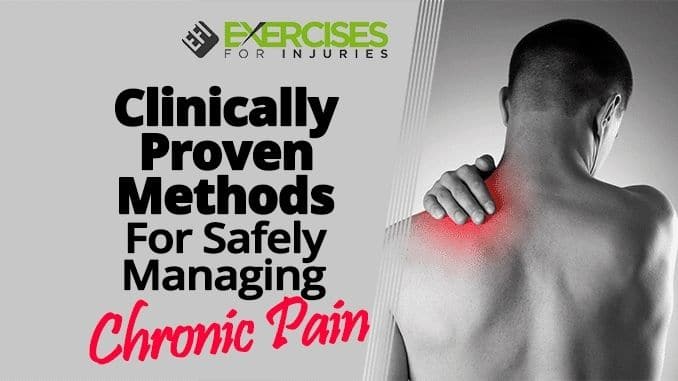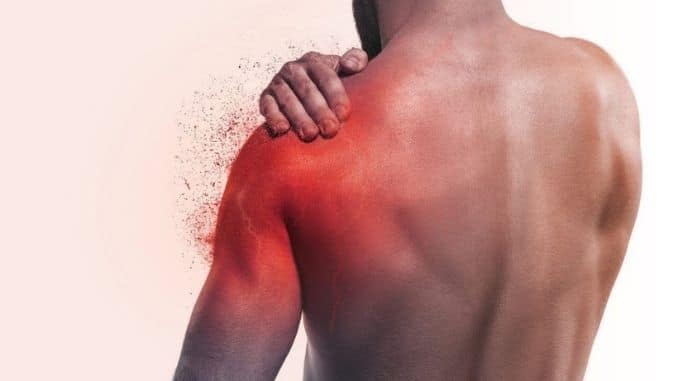
If you suffer from chronic pain, then you understand how debilitating it can be. The name says it all: chronic. This means a long-term problem that affects nearly every aspect of your life. Many people aren’t aware that chronic pain is very common. More than 1.5 billion people worldwide and 100 million Americans suffer from chronic pain.
Chronic pain can affect different parts of the body at once, as with fibromyalgia, or be limited to a particular body part, as with arthritis.
Let’s take a closer look at this problem as well as clinically proven methods for managing chronic pain safely. We’ll also learn about some of the less common ways people deal with chronic pain.
What Causes Chronic Pain?
There is no single cause of chronic pain. In some cases, a sudden injury, such as low back strain, leads to long-standing pain. Also, diseases like cancer can be associated with chronic pain. Other medical conditions are associated with pain as a central part of the illness, such as arthritis or neuropathy (a type of nerve damage). In general, the most common causes of chronic pain are:
- Headache, including tension or migraine
- Postsurgical pain (appears after surgery)
- Post-trauma pain (occurs after injury)
- Lower back pain (with or without prior injury)
- Cancer pain
- Arthritis pain
- Neurogenic pain (caused by nerve damage, like with diabetes)
- Psychogenic pain (pain not caused by disease, injury or nerve damage)
There are also a number of medical conditions commonly associated with chronic pain. These are:
- Chronic fatigue syndrome: Persistent tiredness which can also be associated with pain
- Endometriosis: Abnormal growth of the lining of the uterus that can be very painful
- Fibromyalgia: Persistent musculoskeletal pain that is usually on both sides of the body
- Inflammatory bowel disease: A group of disorders associated with intestinal inflammation
- Interstitial cystitis: Causes persistent pain and pressure in the bladder
- Temporomandibular joint dysfunction (TMJ): A painful condition involving the jaw muscles
- Vulvodynia: Chronic vulvar pain with no known cause
Let’s also mention that understanding the diverse causes of chronic pain is crucial in developing effective methods for managing chronic pain and improving the quality of life for those who suffer from it.
Treatment for Chronic Pain
There are many treatment methods for managing chronic pain. When you consider the wide range of causes, you can tell that each person’s situation is unique. A large part of treatment focuses on treating any underlying disease. For instance, for someone with irritable bowel syndrome (IBS), medication used to treat the disorder might help with pain as well.
There are some chronic pain treatment modalities that can be considered in the treatment of any chronic pain situation. In general, these can be divided into the following categories:
- Medications
- Injections
- Creams and patches
- Lifestyle remedies
Medications for Chronic Pain
A wide range of medications are used for pain relief. Some are taken as needed, while others are taken on a regular basis to “take the edge off” persistent pain. Other classes of medications, such as antidepressants, might also be recommended for pain relief. If you are prescribed an antidepressant for chronic pain, this does not necessarily mean you are depressed. The idea is that the medication also has an effect on the nerve pathways that carry pain signals to your brain.
Some types of oral medications used for pain relief are:
-
Anti-inflammatory and Similar Medications
These are available over-the-counter, but some may be prescription strength. Examples are acetaminophen, ibuprofen, naproxen, indomethacin and aspirin. Many of these drugs fall under the nonsteroidal anti-inflammatory drug (NSAID) category. Taking NSAIDS for long periods may increase your risk of stomach ulcers.
-
Opioid Pain Relievers
These medications were originally derived from the opium plant. They act on special nerve receptors to produce morphine-like effects. Some are derived from plant sources, but synthetic opioids are also commercially available. Some examples are morphine, hydrocodone, oxycodone and fentanyl. These drugs carry a very high risk of addiction. Even after your pain problem is resolved, you could remain addicted to these drugs.
-
Antidepressants
Other nonpain-killer medications are sometimes used to treat chronic pain. Antidepressants such as amitriptyline or duloxetine (Cymbalta) have been used in this way.
-
Anti-seizure Medications (anticonvulsants)
Research supports using some anticonvulsants such as gabapentin (Gralise, Neurontin) or pregabalin (Lyrica) to help relieve chronic pain. These medications are more effective for treating chronic pain caused by nerve damage or fibromyalgia.
Injections used for chronic pain relief are:
- Epidural steroid injections (injecting medication in the spine area): Used to relieve low back or neck pain caused by herniated discs or pinched nerves.
- Joint injection: Steroid medication injected into a painful joint. Provides temporary relief and the total number of injections is limited to three per joint.
- Nerve blocks: Pain relief is achieved by injecting an anesthetic into the affected nerve. Nerve blocks typically only work for a limited amount of time.
- Trigger point injections: A local anesthetic is injected into tender points on the body of some people with fibromyalgia.
- Skin patches and creams: These may contain analgesics such as lidocaine or capsaicin. There are also patches that contain slow-release opioid medications such as fentanyl patches.
Other Modalities to Reduce Chronic Pain
Besides the conventional methods for managing chronic pain mentioned above, there are other ways that people use to relieve chronic pain. Some medical studies support the use of these strategies, but not all of them work for everyone.
Meditation
Being anxious can make pain worse. This could be due to muscle tension or some other mechanism. Meditation helps lower your heart rate and anxiety levels, which may reduce the sensation of pain.
Stress Reduction
Anything that reduces anxiety may be helpful in alleviating pain. Still, reducing stress in your life might not be so easy. It might be worth seeking help from a professional counselor or psychologist.
A mental health practitioner that specializes in cognitive behavioral therapy might be especially beneficial. This type of therapy challenges how you view stress and helps you change thought patterns. Just because you seek mental health services does not mean that your pain is “all in your head.” In the struggle against chronic pain, anything that might help should be considered.
Exercise
Many people with chronic pain have limited mobility. However, if at all possible, some kind of exercise has a good chance of reducing your pain level. One of the reasons is that exercise increases hormones like endorphins in your blood, which makes you feel better. In fact, endorphins are similar to opiates in the way they work, but endorphins are produced naturally in your body in response to exercise. Plus, exercise helps keep your weight down, which may reduce the pain associated with low back pain or arthritis.
Improved Sleep Hygiene
Sleep hygiene means the things that affect your nightly rest. The more rested you are, the more energy and less stress you experience. Some ways to improve your sleep are:
- Establish set sleeping and awakening times
- Avoid using digital devices before bedtime
- Always sleep in your bed, not on the couch
- Don’t eat heavy meals late at night
- Limit your alcohol use to one drink or less per day
- Avoid caffeinated drinks or high-sugar foods and drinks at night
- Try to get seven to eight hours of sleep per night
If you feel you are having chronic sleep problems in addition to chronic pain, it might be worth consulting with a sleep specialist.
Support Groups
These groups can be real or virtual. Sharing your struggles with others helps you to reduce feelings of isolation. Also, methods for managing chronic pain, especially online forums, might give you ideas about how to manage your pain. The other advantage to forums is that you may have an uncommon pain problem that is not well understood by doctors. Forums offer the chance to interact with others and look for solutions together.
Quit Smoking
Even though quitting tobacco may be easier said than done, studies have revealed a link between smoking and chronic pain. Also, those who quit smoking tend to have a decrease in their pain levels. Why this occurs isn’t completely clear, but it might be due to the fact that smoking causes circulation problems. If your circulation is poor, toxins tend to accumulate. Also, oxygen-rich blood has trouble reaching your muscles and nerves, which may play a role in worsening chronic pain.
Keep a Pain Diary
If you keep track of your pain levels daily, you might discover some patterns that you can modify. Most people who suffer from chronic pain already know their triggers, but when you follow your symptoms carefully over a long period of time, you might detect less obvious patterns. For example, certain types of food might worsen ― or even relieve ― your symptoms. Living with chronic pain is kind of like a war. You need to look for any advantage to come out victorious.
Biofeedback
This stress-reducing technique requires special equipment. When you receive biofeedback therapy, sensors are attached painlessly to your skin to monitor your heart rate, breathing rate, blood pressure, amount of sweat, skin temperature and muscle tension. With flashing light signals as a guide, you can learn to control your body’s activity. This allows you to reduce your body’s stress response. Biofeedback is used in combination with techniques such as deep breathing, meditation, progressive muscle relaxation and guided imagery.
Conclusion
Chronic pain does not have simple solutions. Successful management often comes from trial and error. There are also specialists that deal specifically with chronic pain management. Persistence and self-education go a long way to being able to lead a productive life with chronic pain.
If you want to trim down your body, get younger, increase your metabolism and energy, and heal your pain, then check out the Best Foods That Rapidly Slim & Heal in 7 Days, here!




